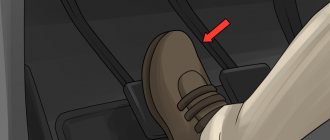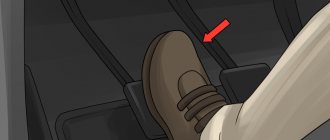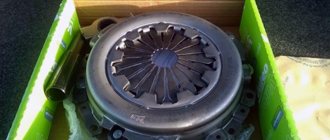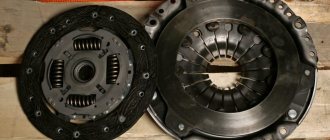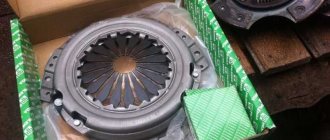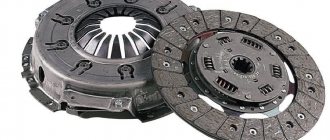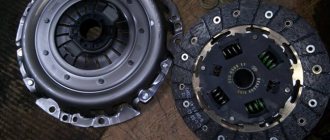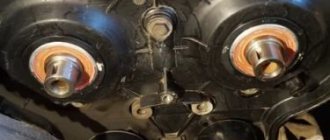Good day, dear car enthusiasts! Each of us is always concerned about how long this or that part or car system will last. It `s naturally. Especially considering the quality of some products, the “skills” of workers, etc.
This issue fully concerns the car’s clutch. Very often on motorist forums there is a serious question about when to change the clutch, and how to know when the time has come to replace it. So let’s try to figure out together what the actual service life of the clutch is, and whether it exists at all.
Is there a certain clutch resource?
Whether or not you will be upset when you find out that the manufacturer does not indicate specific figures for clutch service life. If, for example, in the brake system, it is clearly stated that the thickness of the brake disc should be such and such, then why is this not applicable to the clutch?
The fact is that clutch wear depends on many reasons, and first of all, of course, on how the driver changes gears and in what mode the clutch is used.
And while clutch disc thickness cannot be measured the same way brake disc thickness can be measured with a caliper, there are ways to measure it. There are two of them.
- The first way to measure the thickness of the clutch disc is with a special measuring gauge. This method does not require dismantling the clutch; it is performed on a lift. But you are unlikely to use it.
- the second method is simpler to implement and allows you to determine the wear of the clutch disc in order to replace it. Replacing the driven disk is a procedure provided by the manufacturer, because The driven disk is a consumable part. The check is carried out as follows: with the engine running, you need to put it in high gear, accelerate it, and if the car does not stall, this means that the driven disk is worn out and requires replacement. It must be remembered that such a check of the thickness of the clutch disc is not technologically correct, but it is effective and allows you to determine the condition of the disc extremely accurately.
As already mentioned, the life of any clutch is determined by its operating conditions. Without going into technical details of the interaction of clutch parts, you should understand that basically the life of the clutch and the wear rate of the discs depend only on the driver.
A clutch of the same quality and manufacturer can last 5,000 km for one driver, and 100,000 for another. Participation in drag racing, frequent slipping, abrupt starting at high speeds, ingress of foreign liquids and objects, unqualified installation and adjustment clutch - all this reduces the life of the clutch.
How to check the clutch?
The clutch is checked using already proven and reliable folk methods, and only by them. Naturally, in addition to disassembling the clutch. We are talking about how you can check the clutch of your car yourself, and then decide whether you need a more in-depth diagnostic with dismantling the clutch mechanism.
Lada Priora
The basic “Norma” package includes a driver’s airbag, ESD, central locking, electric front windows, immobilizer, on-board computer and headlight range control. The “Lux” variation is significantly richer. It includes air conditioning, electric windows on all doors, and an airbag for the front passenger. The main advantage of the luxury package is the presence of ABS and EBD. In addition, it received front fog lights, alloy wheels and parking sensors. Initially, the Lada Priora was produced only with a sedan body, in 2008 a hatchback was released, and a year later a station wagon also went on sale. Finally, last year the plant presented a coupe. By the way, any type of body is given a 6-year guarantee against through corrosion.
How long does the clutch last on a Priora AMT?
Found the news ** AVTOVAZ continues to improve the Lada Vesta sedan. The next step in this matter will be to increase the reliability of the clutch assembly on the car.
As the official Lada Club has learned, AVTOVAZ is currently working to improve the reliability of the automated manual transmission (AMT) on LADA Vesta sedans. Changes will be made to the design of clutch discs, which are installed on both AMT and standard manual transmissions.
Representative of the AVTOVAZ press center Stas Bereziy, at the request of Lada Club, clarified: “At the moment, clutch discs of a new design are being introduced. Thanks to the new damper and lining material, the smoothness of clutch engagement has increased, which is especially noticeable when starting the car. New disks will be introduced on all modifications. Let us note that AVTOVAZ fully complies with its obligations regarding warranty replacement of clutch units that may fail or cause discomfort when traveling.” **
YES, AGAIN! Having driven about three thousand, the car began to twitch again, as usual, they trained it, then again, then again... and in the end they said that a NEW clutch had been released, modernized, with catalog number 21703-1601130-3 1
. Yes, at the end there is a number one, according to the warranty provider, new lining material has now been used.
The same shift was doing it as that time, even the same master, only now completely alone. I didn’t remove the subframe, I got through the smoke breaks in 3.5 hours. But this is the total time spent in the service, with washing, receiving a disk, and training for AMT as an electrician. The replacement process itself took probably an hour and a half.
Good afternoon, dear Drayvovites!
What made me write this general post is the fact that most of those discussing the disadvantages and advantages of the AMT Vesta on forums do not have a detailed understanding of this transmission. I've already hung this sheet up.
So: first, some general data: 1. The AMT is based on a modified VAZ 2180 manual transmission. 5 speeds. In the Vesta AMT the gear ratio of the main pair is 3.9; on Kalinas and Grants it is 3.7. On the Kalina AMT, 120 mph corresponds to 3000 rpm. per minute, Vesta: 3,150-3,200. 2. You can’t just “screw” a “canopy” of actuators and an electronics unit onto a regular VAZ 2180 manual transmission to get an AMT output. In terms of hardware, the AMT differs from the manual transmission by a modified housing, a different input shaft with a rotation sensor + a few more “little things” (this is in brief). Upd2.But you can return it to the mechanics. It's really not easy :-). 3. The ZF actuator unit is maintenance-free. Estimated service life is 10 years. The current cost is about 20 thousand rubles. No failure of this unit has yet been recorded. On the prior forum there is a description of disassembling the clutch actuator. Doesn't like overheating. Example of cost (about 13 TR) of a clutch release actuator (article 8450077259): www.google.ru/search?q=84…&source >Example of cost (about 20 TR) of a gear selection actuator (article 21820170501201): scorpion-car.ru/catalog/s…rch?search=21820170501201 UPD 5.
There are isolated cases of actuator failure.
As a rule, at the very beginning of AMT work. Replaced under warranty, no questions asked. And this is in the 4th year since the beginning of mass installation of AMT on cars. 4. “Clutch assembly” AMT modified (relative to manual transmission). The cost of replacement at the moment is about 5.5 thousand rubles. from the officials. Its service life depends on the driver for the most part. AMT tries to take care of him (behaves like a “retired” driver). No failures were noticed during early runs (up to 30 thousand km) (for Kalin-Grant). There are no routine adjustment work until its “death.” In theory, it should last at least as long as an ordinary driver (not a racer!)). On average it is about 100 t.km. during urban use. UPD 6.
On West and X-rays, the composition of the clutch disc linings has changed. In the first half of the year 2016, “weak” clutch discs were produced. Subsequently, the problem went away. 5. Oil poured into the AMT is not officially subject to replacement until 120 thousand km. Unofficially, engineers advise changing to 75 t.km. 6. AMT on cars with ESP (Vesta and, more recently, Viburnum) is additionally linked to the ESP and HSA system (slope holding system. That is, in turns, AMT “holds the gear” without allowing a break in the power flow between the wheels and the engine 7. AMT - adaptive transmission Every second (or rather, each cycle of execution of the main program of the AMT controller. This is several tens of ms), its controller reads data from the engine control units, ESP (ABS), gearbox sensors, gas and brake pedals in order to form necessary actions according to the interference of basic gear shift maps and variables from long-term memory (where the driver’s actions in certain situations are recorded and dynamically adjusted). In non-technical terms: the gearbox adapts to the driver’s driving style and road conditions. To do this, it needs time (according to according to my observations, this is several tens of kilometers in the city). lever to the “+” position (from the second and higher it will switch in the cutoff). 9. AMT quickly detects an increased load (slope or towing someone) and uses the maximum possible engine torque. Those. drives “on the spot”: switches this way. so that the next gear is engaged at least 2.5 t.r.o. per minute and switches to the next gear when it reaches at least 4 - 4.5 rpm. in a minute. The applied torque depends on the amount of load on the engine: for example, on a slight slope, the AMT will simply switch to a lower gear, but will not crank it up, remaining in the economical gear shift corridor. 10. In “M” mode, AMT changes gears faster (about 150-250 ms) than in “A” mode. When the speed decreases (when the engine speed in the selected gear drops to idle), the AMT will automatically engage a lower gear. Accordingly, when reaching maximum speed - increased (with the exception of the first: see point 8).
Lada Priora
As for the frequency of maintenance, the service interval is 15 thousand km. However, the first maintenance visit should be made already at 2-3 thousand. During routine maintenance, the main attention is paid to checking and broaching various units and components. Naturally, each scheduled maintenance will require changing the engine oil and filters - both oil and air. At each maintenance, mandatory adjustment of the gaps in the gas distribution mechanism of an 8-valve engine is prescribed. The 16-valve engine is not so whimsical.
Lada Priora
A mileage of 60 thousand km is critical for the generator drive belt, all engine filter elements and spark plugs. Most likely, at this mileage you will have to flush the throttle pipe and idle air control. Typical symptoms of a malfunction are floating idle speed and jerking of the car during acceleration.
75 thousand kilometers - time to replace the timing belt on an 8-valve engine. In addition, according to the service regulations, such a mileage will become critical for the oxygen sensor, and will also require replacing the fluid in the engine cooling system.
Signs of clutch problems
Often drivers, especially new car owners, when problems arise with the clutch, realize that the car has begun to behave differently, but continue to drive without making any attempts to find out what the reason is. As a result, this leads to serious damage and the car completely fails. Knowing the main symptoms of a clutch malfunction, you can take timely measures - carry out repairs yourself or contact service center technicians or service stations.
Below are the main symptoms of clutch malfunctions and which unit is responsible for this or that atypical behavior.
Incomplete clutch release
Among motorists - “the car is driving.” In other words, when the clutch lever is pressed, the driven disc is partially disconnected from the motor wire shaft. This leads to the fact that the car begins to twitch at the beginning of the movement at the moment of changing gear, even though the pedal is depressed smoothly, as usual.
What causes this problem to occur:
- Small pedal free play. It may be different for each car; you should look for information in the technical data sheet.
- The drive is poorly adjusted. On mechanical and hydraulic drives, the defect is eliminated in different ways.
- Clutch disc deformation. This happens more often when the axial runout value is greater than 0.5 mm. Under such circumstances, the friction lining of the disk bends and presses it against the flywheel of the internal combustion engine.
- Clutch disc wedge in shaft grooves. A common reason is parking the car for long periods of time, especially outdoors.
That is, it is not so easy to determine exactly what led to the clutch failure, because one defect may be the result of damage to one or more elements.
If after adjustment the defect has not been eliminated, the only option is to replace the clutch with a kit. Always change the clutch as a set (disc, basket, release) since saving on spare parts usually leads to repeated disassembly, loss of time and money.
Clutch slipping
The main signs indicating a malfunction of the clutch are the following: pressing the gas pedal almost all the way with the clutch released, the engine “growls”, but the car does not react or the reaction is very weak. In addition, you can hear a characteristic burning smell from the engine compartment, this is due to the clutch disc slipping and, as a result, its heating.
Causes of malfunction:
- The free play of the clutch pedal is out of adjustment (a very rare reason).
- Oil contamination of the friction lining of the driven disc. More common in cars with high mileage. Possible wear of the oil seal or gasket, insufficient joint tightness, etc. can lead to lubricant splashing and getting onto the friction linings (which leads to the smell of burning oil).
- The friction lining is worn.
- Drive faults. Help will be needed to determine this. Looking under the bottom of the car, ask an assistant to depress the clutch pedal. The rod of a working cylinder moves, pushing the fork. Otherwise the drive is damaged.
On a hydraulic drive, the problem may be caused by a clogged compensation hole in the main cylinder.
Almost always eliminated by replacing the clutch with a kit.
The occurrence of atypical noise when depressing the clutch pedal
When the pedal is released there is no extraneous sound. When pressed, a characteristic rustling sound appears, intermittent grinding of different levels and similar noises.
Causes of malfunction:
- The appearance of a gap or insufficient amount of lubrication led to the release bearing crumbling.
- Damper springs or basket petals have failed.
- The driven shaft bearing in the transmission is worn out.
If the release bearing wears out, you can only replace it, BUT only if you are sure that all other clutch elements are in excellent condition. Agree, it will be a shame to remove the box again in a month to replace the disk or basket.
The clutch pedal makes a squeaking sound and does not move back
In this case, you should try to move it to its original position with the toe of your shoe. If this does not help and the squeak remains, most likely the drive is jammed. A loose release bearing may also be the cause. Less commonly, the consequence of such a defect is the jamming of the clutch lever spring (for example, after a long period of inactivity) or the master cylinder rod.
In addition, the bushing on the rod at the place where the pedal is fixed can produce a squeak. In this case, it is enough to lubricate it.
The clutch disengages when the pedal is pressed hard
And when you press or release smoothly, the clutch does not engage. This is a symptom of a faulty hydraulic drive. There are several reasons for its failure:
- depressurization of the transmission system line;
- low fluid level in the system;
- Excessive wear of the master cylinder cuffs.
Car jerks when using the clutch pedal
If the drive is working properly, the reason may be caused by loosening of the friction linings or their wear. In this case, they will need to be replaced.
Insufficient effort when pressing the clutch pedal
More often, low pedal resistance is caused by air in the clutch hydraulic system. You can fix it by removing air - bleeding the system.
Lada Priora
According to the maintenance card, the gearbox oil needs to be changed every 75 thousand km or after 5 years. There is no reason to shorten the service interval. One piece of advice: for TO-1 it is better to change the factory oil to synthetic or semi-synthetic. Believe me, it won't hurt.
In general, the transmission is quite tenacious. The service life of the clutch largely depends on operating conditions and driving style. On average it is 60–100 thousand km. The clutch assembly is replaced - disc, basket, release bearing. In special cases, the flywheel may also require replacement. But this is rather an exception to the rule.
How to check the clutch
Check using a measuring gauge
There are several basic methods that make it possible to answer the question of how to check the clutch on a car. The main assessment methodology is based on the use of modern measuring equipment. More precisely, you will need a measuring gauge.
The advantage of the first method is that it does not require complete dismantling of the clutch. It can be checked on a lift. Of course, this will take a lot of time, but the result will be more than reliable.
If you do not have access to a lift or special equipment, then there are alternative testing methods. They are less reliable, but allow you to determine the approximate condition of this node.
Checking for wear without special equipment when slipping
Of course, verification is carried out only if certain prerequisites are present. Moreover, the diagnostic technique itself differs radically depending on the nature of the malfunction. For clarity, consider a situation when the clutch begins to slip. In this case, the verification algorithm will be as follows:
- Put the car on the handbrake.
- Activate the engine.
- Engage third or fourth gear.
- Depress the clutch and press the gas pedal.
If the engine stalls, then the clutch disc needs to be replaced, as it is too worn. But the result of such a test will only be accurate if the handbrake is properly adjusted.
Checking for slippage
There is a method that allows you to check whether the clutch is slipping. To do this, you just need to carefully monitor the behavior of the car while driving. Poor acceleration, a burning smell, slow entry up hills and a drop in speed indicators indicate slipping.
What if the clutch “leads”
In some cases, the clutch begins to “drive”. Typically, this effect is accompanied by difficulty in shifting gears, and extraneous noise and unpleasant sounds are also possible. In this case, the node testing algorithm has its own characteristics:
- the engine should be running at idle speed;
- depress the friction clutch pedal;
- engage first gear.
If you need to apply too much force when shifting into gear and you hear strange sounds, this means that the disc is not disengaging from the flywheel. To get rid of this defect you need to pump the hydraulics. You will also need to adjust the appropriate pedal. At the end of the procedure, you need to check everything again.
Additional Methods
In fact, motorists have come up with a number of ways to check this part.
- You can check the distance from the floor to the pedal with the clutch on and off. The working stroke should not exceed 146 mm.
- While driving, reach third gear and press the gas pedal sharply. Dissonance between acceleration and rpm will be a sign of trouble.
- Failure to engage the gear means complete failure of the unit.
These methods will help you check the functionality of the unit and, if necessary, carry out repairs.
As you can see, checking the clutch is not that difficult. Moreover, you don’t have to go to a service center for this. It is enough just to carry out a number of simple manipulations in a certain sequence.
How to check clutch discs for wear is shown in the video:
In mechanics, a clutch is a mechanism whose operating principle is based on the action of sliding friction. Often the term "clutch" is used to refer to one of the components of a vehicle's transmission that is used to connect the engine flywheel to the transmission. Depressing the clutch pedal temporarily disconnects the power transmission from the engine.
The clutch mechanism is necessary so that you can start smoothly from a standstill, without jerking. The speed of the car begins to increase only at a certain minimum number of engine revolutions. The clutch is also used when it is necessary to match the vehicle speed and the engine crankshaft speed, that is, it ensures smooth transmission of torque from the engine to the gearbox and, if necessary, at some point completely disconnects the manual transmission gears from the engine transmission mechanism.
There are several different types of clutch. Often these are one, two or more friction discs, pressed tightly against one another or against the flywheel using springs.
When the driver presses the pedal, the clutch discs are disconnected, and an air gap appears between them; the clutch is disengaged at this moment, and torque is not transferred from the engine to the gearbox. If the pedal is released, the clamping springs return the discs to their initial position, and they again come into close contact; the torque from one drive disc is transmitted through the action of friction to the driven disc.
The clutch is one of the very important components of a car. Various types of these mechanisms are classified according to the control method, the type of friction operating in this case (dry friction or wet friction), the number of disks, and so on. As engine power increases, torque also increases; accordingly, double-disc clutch systems are used, which have a longer service life.
Sooner or later, clutch discs wear out and require replacement. Clutch malfunctions can lead to failure of other parts of the car, for example, gears of the gearbox mechanism, or even to the inability to start the car on the road.
How to understand when it's time to change the clutch
If, when the clutch is disengaged, a strong noise is heard, which is created by the release bearing, this indicates that it is worn out. Clutch wear leads to increased, wasteful fuel consumption as a result of a significant loss of engine power at this automotive unit.
One of the problems with clutch operation is slipping of the discs when the pedal is freely released. As the discs slide past each other, they become very hot, which leads to rapid deformation or failure of the discs. Friction linings burn, and a specific smell can be heard inside the car.
How can you check problems in the clutch system yourself, without going to a service station, as they say, the traditional way? The driver may notice the discs slipping at first in high gears. At the same time, the engine speed increases, but the speed does not increase. Having noticed this state of affairs, it is necessary to take action, as the process develops, intensifies, and, in the end, it will reach the point that the car simply cannot start moving when first gear is engaged.
What is the service life of the clutch mechanism? The answer to this question is ambiguous. After all, the service life of this mechanism depends not only on the quality of production, but also on the experience and driving technique of the driver himself. According to the unspoken rule of motorists, discs are replaced after driving eighty to ninety thousand kilometers. But these indicators can deviate in any direction.
CHASSIS
The car received front and rear shock absorbers with improved characteristics. This had a positive effect not only on driving performance, but also on the life of the suspension. Nevertheless, no one, of course, canceled the regulations. Scheduled maintenance comes down to diagnosing the condition of suspension components and assemblies, periodically adjusting the angles of the front wheels (every 30 thousand km), regularly checking the condition of the brake system and scanner diagnostics of the electric power steering. Every 45 thousand kilometers, or every 3 years, the fluid in the brake system must be changed. Of course, there are some negative points here too. So, most likely, even before the first hundred thousand kilometers, ball joints, steering tips and wheel bearings will remind you of themselves. Their resource, as a rule, is limited to 60 thousand km.
Clutch sensor
The popular Priora was designed in the spirit of the times, so the computer even controls such a unit as the clutch. The electronics do not control the process of turning the clutch on and off, but the clutch sensor on the Priora, installed under the clutch pedal, collects information about the position of the pedal. This data enters the electronic engine control unit and is used to optimize engine operation depending on the driving mode, and also makes it possible to use cruise control on the car.
How does the electronic engine management system work?
The electronic engine control unit controls most of the vehicle's components, excluding the steering and suspension. ECU programs include presets (tables), according to which optimal operating modes are calculated. Many sensors installed on the car read information about speed, movement, engine speed, activated mechanisms and units. Based on the tables, the ECU changes the ignition mode, turns on additional functions and regulates the composition and amount of the air-fuel mixture entering the cylinders.
Functions of the Priora clutch sensor
Data about the current mode of the clutch mechanism is important for engine control. If the clutch is open, it is necessary to reduce the fuel supply and reduce engine speed. It is optimal to do this in accordance with the current speed of the vehicle, without switching to idle mode.
A driver, especially an inexperienced one, may make mistakes, which leads to increased load on the engine and clutch. The on-board computer, based on the readings of the clutch sensor, adjusts the engine operating mode, setting the optimal speed.
Also, the clutch sensor on the Priora, in combination with the speed sensor, allows the computer to evaluate the performance of the unit and signal problems.
Installing a clutch sensor on a Priora allowed:
- reduce fuel consumption;
- make driving easier and more enjoyable;
- control the serviceability of the coupling;
- extend clutch life.
Therefore, the serviceability of the sensor affects the service life of the units, fuel consumption and is extremely important for the correct operation of the ECU.
Operating principle of the Priora clutch sensor
What is a Priora clutch sensor? The operating principle of the device is no different from a simple limit switch. When the pedal is not pressed and the clutch is engaged, the sensor contacts are open. When you press the clutch drive, the limit switch closes, sending a signal to the computer to separate the clutch disc and basket.
The clutch sensor is installed on the pedal mounting assembly so that the tip of the pedal touches the limit switch.
The sensor design is simple and reliable, but this does not exclude the possibility of breakdowns and malfunctions in its operation.
Signs of a malfunction of the Priora clutch sensor
This sensor is connected to the car’s ECU; accordingly, the first sign of a breakdown is the reaction of the control unit in the form of the appearance of a corresponding signal on the dashboard. The nature of movement and operation of the car engine also changes. Symptoms of malfunction are as follows:
- The “Check Engine” light is on;
- when starting to move the car jerks;
- When you press the clutch pedal, the engine speed rises or falls sharply.
The warning lamp on the instrument panel lights up if the computer does not receive a signal from the clutch sensor within 2 seconds from the moment the vehicle starts moving or within 4 seconds when changing speed while the vehicle is moving.
The sensor has a very simple design, so there are few reasons for failure:
- faulty sensor contacts;
- break or short circuit of the wires going to the sensor;
- Incorrect installation of the sensor near the pedal.
Important: the clutch sensor is installed only on Priora models equipped with an electronic throttle. If the car is equipped with a regular throttle cable, there is no clutch sensor. Also, when replacing a sensor, you should focus on its model. Sensors from all-wheel drive VAZ and Priora sensors are not interchangeable.
Replacing the Priora clutch sensor
To dismantle the Priora clutch sensor, you just need to unscrew the two screws holding it to the clutch pedal. But to get to them, you need to do a lot of operations. Removing the Priora clutch sensor is done as follows:
- remove the windshield wiper blades;
- remove the left casing (jabot);
- remove the rubber casing covering the clutch pedal;
- unscrew a pair of screws securing the clutch sensor;
- remove the clutch sensor.
After removing the sensor, you can replace it with a new one or repair it.
The sensor is installed like this:
- secure the sensor with self-tapping screws;
- install the rubber clutch pedal cover;
- install frill;
- secure the windshield wiper blades.
Repair of the Priora clutch sensor
Often, sensor malfunctions can be easily resolved without replacing it.
First you need to check whether the sensor end reaches the clutch pedal pusher. If the pusher does not press on the limit switch, it is necessary to adjust the position of the sensor relative to the pedal.
Another common failure is a break in the wires going to the sensor contacts. This malfunction can be easily detected by checking that the wires are securely fixed with your fingers. To fix this problem, you need a soldering iron, solder and rosin. When the sensor is removed from the car, soldering wires to its contacts is not difficult.
If the sensor wires are not broken and the limit switch reaches the pusher, the problem may be a faulty sensor contact or a broken limit switch. They may oxidize, become deformed or break. The functionality of the contacts can be checked using a multimeter. To do this, you need to connect the device to the sensor terminals and check the change in resistance between them when you press the limit switch.
Oxidized contacts can be cleaned, restoring the functionality of the sensor. If this does not work, it should be replaced. The price of this part is low, and you can buy it at most auto stores.
Source: https://ladaservice.info/lada-priora/elektroborudovanie/datchik-stsepleniya-na-priore/
Nikita Kotrovsky
Lada Priora is a fairly practical purchase. Good technical characteristics coupled with acceptable performance characteristics determined the popularity of this car. The key to peace of mind over time is timely, high-quality maintenance and, of course, careful operation.
Nikita Kotrovsky , editor
Communities › Lada Priora Club › Blog › how long does the clutch last?
Hi all. Guys, how long does the factory clutch last on a Prior? My mileage is 109,000 km and there is an option with a new clutch for free. So I’m puzzled, is it worth changing or not?
It wouldn't hurt to know
What do most owners of new Lada Priora do? Naturally, they treat the body with Movil or something similar against corrosion; they don’t have any more problems at the initial level. However, there were complaints about squeaking when pressing the clutch pedal; sometimes it was present when the engine was warm, sometimes only when it was cold - the essence is that there is a problem.
Of course, everyone immediately starts reading the “primer book” on how to correctly adjust the clutch on their Priora, which sometimes helps, but the fact of the matter is that sometimes. After this, owners can try several more methods, after which the squeak may disappear:
- Replace the drive cable, some drivers praise the “tenth”.
- Check the presence of a spring in the automatic tension mechanism; sometimes the effect can be achieved after replacing the standard part with a spring with greater elasticity.
- A certain percentage of car enthusiasts get rid of the crackling noise by lubricating the fork and the plastic cable nut.
- Lubricate the installation site of the plastic bushing on the pedal bracket with lithol.
- Remove the boot from the fork lever and lubricate the gearbox input shaft with graphite grease from a can.
It is worth considering another effective method, shown in the video, which is used by experienced car enthusiasts. Its essence is as follows:
- Disconnect the mass air flow sensor and remove the air filter.
- Remove the clutch release rod plug.
- Release the cable from the clutch fork.
- Pour 30-40 ml of gear oil from a syringe.
- Move the fork back and forth 10-15 times.
- Reinstall the cable, plugs and filter.
Using the example of the second part of the article, it becomes clear that adjusting the clutch drive does not always bring the desired effect in the fight for acoustic comfort. Although, from a technical point of view, the procedure is necessary, since it ensures productive operation of the car.
Greetings to the Priors, a question has arisen! What is the service life of the Priors clutch? My mileage is 32, mostly in the city, and Moscow is usually one big traffic jam, and I wonder when it’s getting ready for replacement?!
Comments 38
37500 changed the clutch cable on the 10th, the release whistle whistled
I have 57 thousand... we drive normally, I also don’t know when to change it, but I’m wondering why in the service book for regulated work (up to 105 thousand) replacement is not provided at all, as, by the way, is the replacement of the timing belt... why? in their opinion, do they have more resources?
So far 10 thousand have passed, but as I was told, this is my first car, I started driving it in the summer, they told me the clutch and 10 will not pass, you will kill me, apparently everything is not so bad, until I killed it, I hardly burned it, I started it 5 times, 1 time behind the overpass I smelled it. The release button will hold it together a little when it’s cold, but not always, as soon as I start adjusting the cable it starts, and then over time it stops, but when it’s really cold, -15, -17 it starts to buzz:((I’m thinking about installing Valeo later, they say good things, but then who knows him
While the car is new, I recommend adjusting www.vaz-autos.ru/priora/129.htm and the release lever whistles from the factory for all 52500, and the release valve is still original
At neutral speed should there be an adjustment?
it varies, sometimes the release lever comes faster, and those who don’t quite understand that it is jammed, eats and breaks the petals, a friend on a Prior had the release lever eaten and broke the petals at 75 thousand, I drove 100k on the clutch on my 2112, but I changed the release lever, I could I would have traveled another 20 thousand, but I removed the box, and the clutch was in stock prior to bow, I installed a new one
63 thousand, does not slip, but there is a feeling that the clutch is gradually ending... Let's see what happens next
I have 107t.km. still alright
96000 is original, I was also thinking about replacing it))
a friend drove 180,000 km on his original clutch! yes yes 180t.km! I'm on the first Priora 90t.km without problems
this is already an indicator, well, it’s unlikely that I spend so much time; I live in Moscow every day, stuck in traffic jams.
I have a Priora right now, it’s from Perm, it’s a big city, the mileage is 60,000 km and the first owner says that he’s already changed it
Tags: prior clutch
250 thousand passed natively. When they changed the service, they said that this couldn’t happen!
The old Priora has the entire factory clutch 120k, but it’s time to change it, or else!
I changed mine at 80 when I was tuning the gearbox, but I think it would have worked until 100. I advise you to think about replacing it already, otherwise you can still get into trouble with the flywheel
Check clutch discs for wear.
Accelerated self-training course for novice drivers: Sign up for lessons...
Why was the clutch on the Lada Grant only enough for 50 thousand!?
Clutch Kit Parts
in a car that has covered 50 thousand km. Let's see what the details look like. My…
I changed it to 150 current because the box was removed, the clutch was in good condition, it went through even more easily)
They changed it for 180,000, but the basket was covered, the disk was changed for the company.
It's worth it for free!
114,000 - it’s already slipping. It all depends on your driving style and where you drive. So take it, it might come in handy =))
Actually, the clutch is checked “Classically”! Turn on 3rd and start moving. if he eats. That means she's fucked! If it crashes everything is ok!6)
165 thousand, original clutch
If there are no problems, don't interfere with the machine's operation.
If there are no problems, don't interfere with the machine's operation.
If you get a clutch kit (disc, basket, release) for free, then take it and put it in the garage, and change it if necessary. There’s no point in flattery ahead of time.
as long as it goes, so much goes! Change it if you want, don't change it if you want!
The check is elementary, you stand still and start at high speeds with axlebox, if the tires light up and go away normally, it means it’s still working! If it starts hard without axleboxes, it means it’s dead!
Checking the clutch for slipping
Let's first talk about the car slipping when the clutch pedal is depressed, and then we'll talk about driving, since various breakdowns lead to these two situations. As for slipping, it can be noticed by the following signs. When climbing even a small hill, the car accelerates poorly, or even loses speed altogether. There may also be a burning smell in the cabin, indicating that the discs are not compressed enough. In this situation, we recommend that you perform the following check. Set the parking brake and start the car. During normal clutch operation, as soon as you try to move, the engine will stall. If this does not happen, then your clutch is slipping. This usually happens for the following reasons:
- malfunctions in the operation of the hydraulic drive that disengages the clutch;
- wear of clutch release springs;
- wear of clutch friction linings;
- long clutch pedal travel.
A more accurate diagnosis can be carried out at a car service center, but here we have simply given the most common causes of slipping - so that you are aware.
